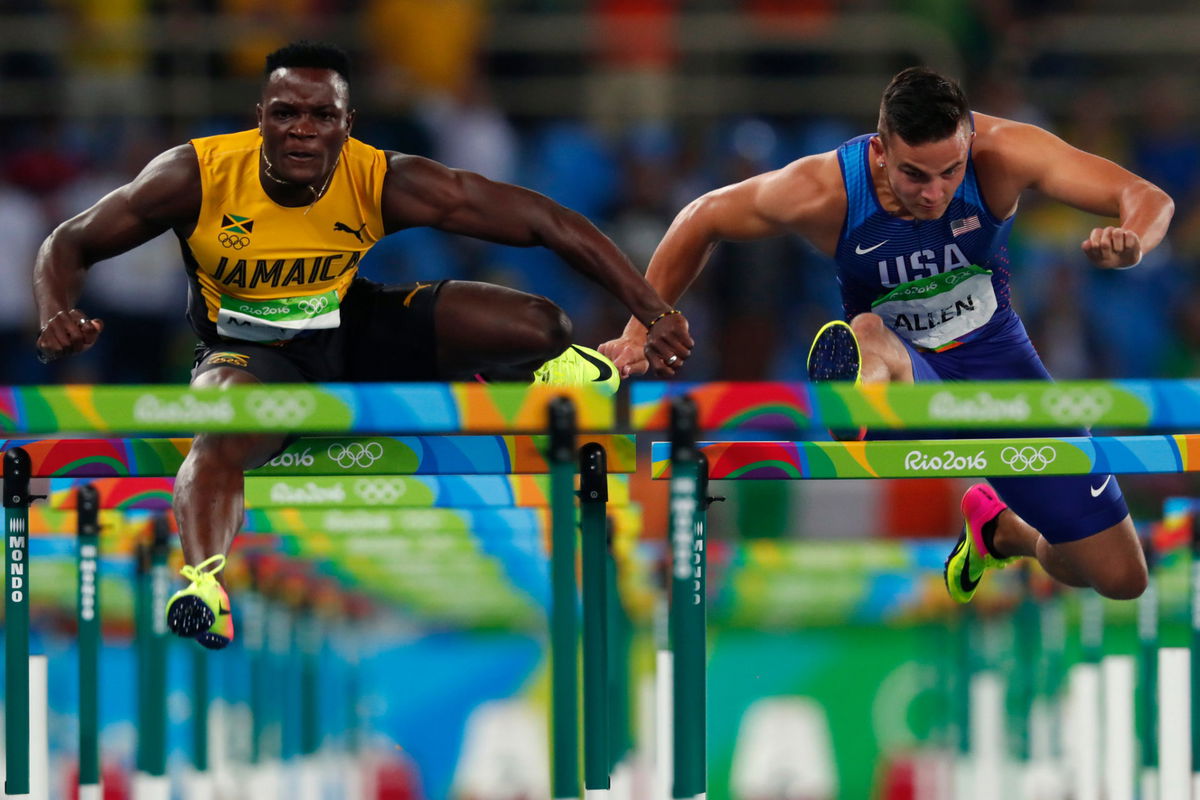

Hurdle races have been an active inclusion in the Olympic Games ever since they were revived in 1896. As a running race with a stipulation, hurdles pose a challenge not only to speed but technique and precision. Even the slightest mistake can cost one the race, and only the most efficient and effective athlete ends up winning.
Watch What’s Trending Now!
As the name suggests, hurdles involve obstacles scattered throughout the race distance, and athletes are expected to clear every obstacle on their way to the finish line. Competitors have to jump vertically over the hurdle and manage to do that across the entire race.

Getty
EUGENE, OREGON – JUNE 26: Grant Holloway competes in the Men’s 110 Meters Hurdles Semi-Finals on day nine of the 2020 U.S. Olympic Track & Field Team Trials at Hayward Field on June 26, 2021 in Eugene, Oregon. (Photo by Patrick Smith/Getty Images)
The hurdles are typically made of wattle, which is the wood used to build fences. Hazel or willow are generally used, which makes these obstacles incredibly sturdy. Athletes are not allowed to intentionally knock over these hurdles and will be disqualified if they do.
ADVERTISEMENT
Athletes must try not to trip over the hurdles
If an athlete accidentally knocks over a hurdle, they are not disqualified but the loss in momentum will cause them to lose the race anyway. Hurdles are weighted, so knocking them over takes its toll on the runner, and many fall to the ground upon tripping on them.
ADVERTISEMENT
ADVERTISEMENT
Hurdles are run across various distances, although the general ones still employed nowadays in the Olympics are the 100m hurdles for women, 110m hurdles for men, and 400m hurdles for both men and women.
Read more: The Interesting Origin of Athletic Events to Be Held at the Tokyo Olympics 2021
ADVERTISEMENT
The hurdles are typically 42 inches tall (106.7 cm), and these hurdles are used for the men’s 110m race. It is also known as “college high” or “open high”. A 36-inch hurdle is used for the men’s 400m race, given the long distance. A 33- inch (83.8 cm) hurdle is used for the Women’s 100m race, also known as the “Women’s high”.
Top Stories
Sources: John Harbaugh Wasn’t Fired, Left Ravens After Refusing Major Staff Changes

Bill Cowher’s Strong Message to Steelers on Firing Mike Tomlin After HC’s Blunt Playoff Message

Bengals’ Cam Taylor-Britt Sentenced to Jail: Everything We Know About Charges Against Him

Kyle Tucker Handed Blunt Reality Check as Blue Jays Shift Focus to Bolster Vladimir Guerrero Jr.

US Visa Rejections Put Major Track & Field Records at Risk at World Cross-Country Championships

Chiefs’ $58M News Complicates Travis Kelce’s Return As TE Gets 8-Figure Update


ADVERTISEMENT
The hurdle race is won and lost over technique
Every race has 10 hurdles set along the track and athletes have to clear all of them before heading to the finish line. Ideally, contestants take about 8 steps before jumping over the first hurdle. Athletes try their best to avoid a stutter step, in which they are forced to break their stride to jump over a hurdle. This makes many lose balance and costs them valuable time and energy.
ADVERTISEMENT

ADVERTISEMENT
The technique is extremely important in this sport as speed alone cannot win the race. Hurdlers have to maintain a low center of gravity while leaping and keep one leg straight as it heads over the hurdle while the other leg is typically bent in the air to give better traction in landing and continuing the run. The arm opposite to the lead leg is kept parallel to the ground to maintain balance.
Generally, athletes will begin a leap 6-7 feet before reaching the hurdles. The jump must minimize energy wasted and maximize momentum which is why the devil is in the details. The ending is simple- the athlete who crosses the finish line torso first will be declared the winner of the race.
ADVERTISEMENT
ADVERTISEMENT
ADVERTISEMENT

